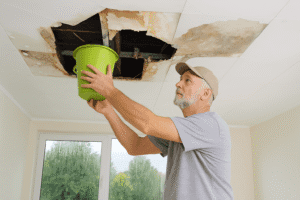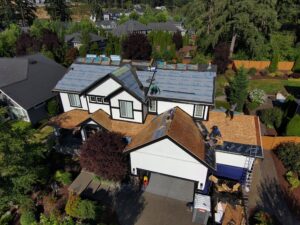When a severe storm hits your home, your roof takes the brunt of the impact. Wind, hail, and falling debris can cause significant problems—many of which aren’t immediately visible. Knowing what steps to take after experiencing roof storm damage is essential to protecting your home from further issues like leaks, mold, or structural damage.
In this guide, we’ll walk you through how to assess a storm damaged roof, what signs to look for, and how to determine whether you need repairs or a full roof replacement.
First Steps After Storm Damage to Your Roof
Prioritize Safety First
After a storm, safety comes first. Avoid walking on a potentially unstable roof. Instead, inspect from the ground or use binoculars to check for obvious signs like missing shingles, exposed underlayment, or debris.
Document the Damage
Take clear photos of any visible roof storm damage as soon as it’s safe to do so. This documentation can help support an insurance claim or serve as evidence for your roofing contractor.
Schedule a Professional Roof Inspection
Not all damage is obvious. A qualified roofing inspector can identify hidden issues like lifted shingles, punctured flashing, or water intrusion points. If your home has experienced storm damaged roof issues in the past, regular inspections are even more crucial.

Common Signs of Roof Storm Damage
High winds, rain, hail, and falling branches can all cause roof storm damage in different ways. Here’s what to look out for:
- Missing or cracked shingles
- Granule loss on asphalt shingles
- Bent or torn flashing
- Leaks or water stains in the attic or ceiling
- Sagging rooflines
If any of these signs appear after a storm, it’s time to call a professional for an inspection.
For a deeper dive into replacement timing, read:
How to Tell When You Need a Roof Replacement
Roof Repair vs. Replacement After Storm Damage
Depending on the severity of the damage, you may be facing either minor repairs or a full replacement. For example, a few missing shingles from wind may only require patchwork. But if the structure has been compromised, a replacement may be the safest long-term option.
Keep in mind that ignoring roof storm damage can lead to expensive structural repairs down the road. If your roof is nearing the end of its lifespan or has a history of issues, replacement might be more cost-effective.
If you want to know more about it:
5 Signs You Need a Roof Replacement
Insurance and Storm Damaged Roof Claims
Understand Your Coverage
Most homeowners’ insurance policies cover storm damaged roofs, but you’ll need an official inspection and estimate to start the process. Be sure to notify your insurance provider quickly, and keep all documentation organized.
Work With Trusted Roofing Professionals
A reputable roofing contractor can assist with the inspection report, insurance documentation, and even negotiate on your behalf. Make sure to choose a contractor experienced with roof storm damage claims to ensure you receive fair compensation and high-quality repair work.
Final Thoughts on Roof Storm Damage Response
When your home experiences storm damaged roof issues, quick action can prevent further damage and higher costs. Whether it’s inspecting for shingle loss or filing an insurance claim, knowing what to do after a storm is critical.
Need Help with Roof Storm Damage? Contact Orca Roofing now
Roof Storm Damage FAQs

How to check for roof damage after a storm?
After a storm, begin with a ground-level inspection. Look for missing shingles, dented flashing, debris on the roof, or granules in gutters. Inside, check for ceiling stains, attic leaks, or musty odors. If you suspect roof storm damage, schedule a professional inspection to assess hidden structural issues safely.
How to protect your roof from storm damage?
Routine maintenance is key. Trim overhanging branches, clean your gutters, and secure loose shingles or flashing. Investing in wind- and impact-resistant roofing materials can also reduce the risk of a storm damaged roof. Regular inspections—especially before and after storm season—can help you spot vulnerabilities early.
What to do if you have roof storm damage?
Start by documenting the damage with photos for insurance. Avoid climbing onto the roof yourself. Cover visible leaks with tarps if safe to do so. Then, contact a licensed roofing contractor immediately for a storm damage inspection. Quick action can prevent further deterioration and may help streamline the claims process.


